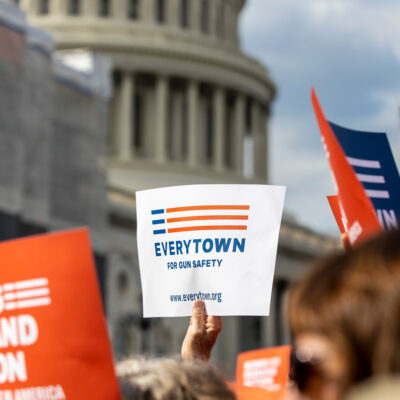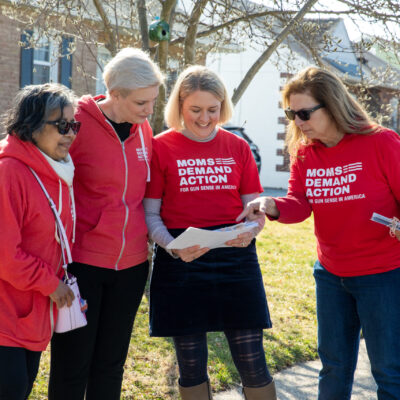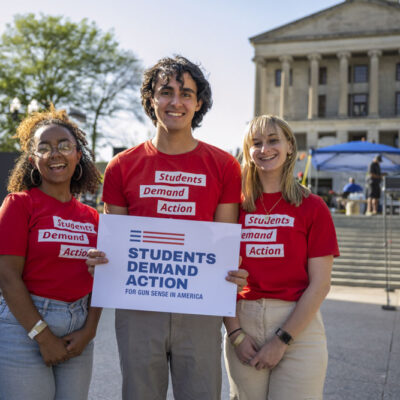City Gun Violence
What is the problem?
Gun violence is prevalent in many U.S. cities, particularly in historically underfunded neighborhoods. It spreads through social networks and intensifies long-standing inequities and public health disparities.
An Everytown Research analysis of FBI crime data from over 600 cities found that over half of the country’s reported gun homicides occurred in just 42 cities, including Chicago, Philadelphia, Memphis, Houston, and others.1Everytown for Gun Safety Support Fund, “City Dashboard: Gun Homicide,” October 2024, https://everytownresearch.org/report/city-data/. Everytown Research analysis of FBI NIBRS data, 2023, accessed October 2024. The full list of cities includes: Chicago, IL; Philadelphia, PA; Memphis, TN; Houston, TX; Los Angeles, CA; Washington, DC; Dallas, TX; Detroit, MI; Baltimore, MD; New York, NY; Phoenix, AZ; Kansas City, MO; Milwaukee, WI; Indianapolis, IN; St. Louis, MO; San Antonio, TX; Louisville, KY; Cleveland, OH; Atlanta, GA; Oakland, CA; Birmingham, AL; Nashville, TN; Las Vegas, NV; Albuquerque, NM; Charlotte-Mecklenburg, NC; Fort Worth, TX; Columbus, OH; Denver, CO; Greensboro, NC; Minneapolis, MN; Cincinnati, OH; Portland, OR; Richmond, VA; Austin, TX; Little Rock, AR; Oklahoma City, OK; Seattle, WA; Baton Rouge, LA; Gary, IN; Newark, NJ; Stockton, CA; and Rochester, NY. Nonfatal shootings are also prevalent in cities, and these injuries can have devastating consequences for the rest of a survivor’s life.
There are a wide variety of evidence-informed solutions to reducing gun violence and increasing safety in these communities. These community violence intervention programs include street outreach, Hospital-Based Violence Intervention Programs, and more. City governments should partner with local advocates, residents, survivors, and researchers to ensure that applied strategies are appropriate for and responsive to local contexts.
Why is it an issue?
Gun homicides intensify long-standing inequities.
Within cities, only a small percentage of the total population live within the social networks that are most likely to be involved in gun violence.1Melissa Tracy, Anthony A. Braga, and Andrew V. Papachristos, “The Transmission of Gun and Other Weapon-Involved Violence Within Social Networks,” Epidemiologic Reviews 38, no. 1, (2016): 70–86, https://doi.org/10.1093/epirev/mxv009. The majority of these people live in neighborhoods that are characterized by high rates of poverty; racial segregation and discrimination; as well as many other deep-rooted systemic and structural inequities.2Mudia Uzzi et al., “An Intersectional Analysis of Historical and Contemporary Structural Racism on Non-Fatal Shootings in Baltimore, Maryland,” Injury Prevention 29, no. 1 (2023): 85-90, https://doi.org/10.1136/ip-2022-044700. While the vast majority of residents are not directly involved, the trauma of this ever-present gun violence reverberates throughout their neighborhoods and impacts their lives. Communities facing imminent gun violence crises require immediate and locally-driven interventions in addition to larger scale policy reform. Comprehensive solutions to gun violence must recognize the role of social contagion and local context in cities,3Andrew V. Papachristos, Christopher Wildeman, and Elizabeth Roberto “Tragic, but Not Random: The Social Contagion of Nonfatal Gunshot Injuries,” Social Science & Medicine 125 (2015): 139–50, https://doi.org/10.1016/j.socscimed.2014.01.056; Ben Green, Thibaut Horel, and Andrew V. Papachristos, “Modeling Contagion Through Social Networks to Explain and Predict Gunshot Violence in Chicago, 2006 to 2014,” JAMA Internal Medicine 177, no. 3 (2017): 326–33, https://doi.org/10.1001/jamainternmed.2016.8245; Anthony A. Braga, Andrew V. Papachristos, and David M. Hureau, “The Concentration and Stability of Gun Violence at Micro Places in Boston, 1980–2008,” Journal of Quantitative Criminology 26 (2010): 33–53, https://doi.org/10.1007/s10940-009-9082-x. and supplement policies with community and data-driven violence intervention initiatives.
By the numbers
42 cities
In 2023, over half of the country’s reported gun homicides occurred in just 42 cities, including Chicago, Philadelphia, Memphis, Houston, and others.
>4 in 10
More than four in 10 gun deaths in cities are suicides.
<4%
Fewer than 4 percent of 911 calls are related to violent crime, even in cities with high homicide rates.
What are the solutions?
-
Violence Intervention Programs
Community violence intervention programs provide evidence and community-informed, comprehensive support to individuals who are at the greatest risk of gunshot victimization. These programs are shown to reduce gunshot woundings and deaths in the neighborhoods most impacted by gun violence.
-
Victims of Crime Act (VOCA) Assistance Funding
Victims of Crime Act (VOCA) victim assistance funds are federal funds that can be used to support services for victims and survivors of gun violence. Many of the services eligible for VOCA victim assistance funds are already being provided by gun violence intervention programs, such as street outreach and hospital-based violence intervention programs. VOCA victim assistance grants should be used to help reduce gun violence and support gun violence survivors.
-
Prevent Gun Trafficking
The United States lacks strong federal gun trafficking laws to crack down on illegal gun trafficking networks. Congress should pass robust gun trafficking and straw purchasing laws to help keep guns off our streets.
-
Repeal Restrictions on Gun Trace Data
Since 2003, the Tiahrt Amendments have restricted law enforcement’s ability to investigate and prosecute gun crimes. This data-blocking protects corrupt gun dealers and hinders law enforcement.
-
Repeal Gun Industry Immunity
The Protection of Lawful Commerce in Arms Act (PLCAA) blocks legal responsibility for gun manufacturers that have failed to innovate and make guns safer, and for manufacturers, distributors, and dealers with irresponsible, reckless and negligent sales practices that contribute to the flood of illegal firearms in our communities.
-
Report Lost and Stolen Guns
Hundreds of thousands of guns are lost or stolen from private gun owners, gun dealers, or shipping companies every year.1ATF, “National Firearms Commerce and Trafficking Assessment (NFTCA), Volume II: Crime Gun Intelligence and Analysis—Part V: Firearm Thefts,” January 2023, https://www.atf.gov/firearms/docs/report/nfcta-volume-ii-part-v-firearm-thefts/download. Requiring that lost and stolen guns be reported to law enforcement deters illegal gun trafficking. The reporting of these guns allows the police to respond more quickly to gun thefts and helps them identify tracking patterns.
-
Gun Dealer Reform
Laws on how gun stores conduct their business have not been strengthened since the 1960s. Congress should pass comprehensive gun dealer reform.
-
Prohibit Auto Sears, Bump Stocks, and Other Rapid-Fire Devices
Fully automatic machine guns—those that fire bullets in rapid succession with a single pull of the trigger—and the parts used to create them have been tightly regulated under federal law since the 1930s.1US Bureau of Alcohol, Tobacco, Firearms and Explosives, “National Firearms Act,” April 7, 2020, https://www.atf.gov/rules-and-regulations/national-firearms-act. However, the gun industry and third-party sellers continue to produce devices that make it easy to convert semi-automatic firearms into illegal machine guns in a matter of minutes.




